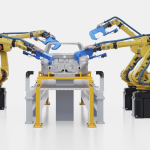Many Industrial Internet of Things (IIOT) projects never move beyond pilot programs. Here’s how manufacturers can break through implementation roadblocks.
The Reality of IIoT Adoption
The Industrial Internet of Things (IIoT) holds massive potential for companies, promising real-time visibility, predictive analytics, and automation that can enhance efficiency, resilience, and profitability. Yet, despite widespread enthusiasm, many IIoT initiatives fail to scale beyond limited pilot projects. Implementation roadblocks—including integration challenges, data silos, unclear ROI, and organizational resistance—prevent companies from realizing IIoT’s full potential.
For companies, the challenge isn’t just adopting IIoT but ensuring it delivers measurable value across production, logistics, and supplier networks. Without a clear roadmap for scaling, many IIoT investments end up as isolated experiments rather than transformational tools.
Breaking Through IIoT Barriers
One of the most common reasons IIoT projects stall is the struggle to integrate with legacy infrastructure. Many manufacturers operate on decades-old systems that were never designed for seamless connectivity. Rather than attempting a full system overhaul, companies that succeed with IIoT take a phased approach, starting with high-impact areas and ensuring compatibility with existing operations before expanding.
Data fragmentation is another major obstacle. IIoT generates vast amounts of real-time data, but without a unified strategy, organizations struggle to extract actionable insights. The key is to create a structured data management framework that ensures information flows across all relevant systems—enabling predictive maintenance, process optimization, and supply chain visibility.
Beyond technology, internal resistance can slow adoption. Frontline teams may view IIoT as a disruptive force rather than a productivity enabler. Successful implementations prioritize change management, ensuring employees understand how IIoT enhances their roles rather than replacing them.
A Playbook for Scalable IIoT Success
Organizations that successfully scale IIoT take a strategic approach, aligning investments with broader supply chain and production goals. They align IIoT investments with broader business objectives, focusing on outcomes rather than just technology adoption. Company-wide alignment is crucial, with cross-functional collaboration—ensuring IT, operations, and production teams are working toward the same goals.
A clear roadmap for scaling is essential. Rather than launching large-scale initiatives with uncertain outcomes, companies should focus on incremental wins—proving IIoT’s value in targeted areas before expanding across the organization. Prioritizing interoperability, structured data governance, and workforce engagement ensures IIoT moves from pilot to full-scale deployment.
The benefits of IIoT are evident, but turning potential into results requires a structured approach that aligns technology with business priorities. Organizations that successfully implement IIoT will see reduced downtime, faster decision-making, and stronger supply chain coordination, giving them a measurable advantage in an increasingly connected industrial environment.







